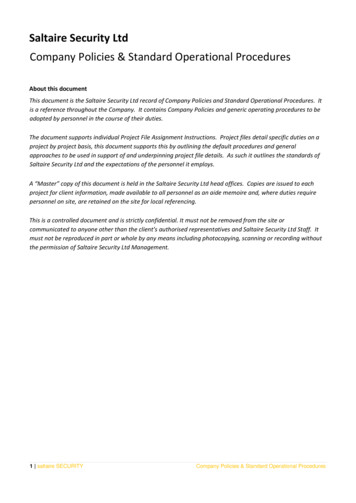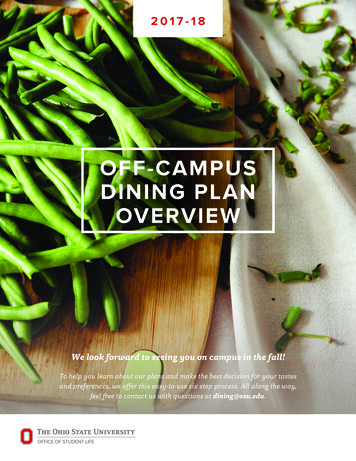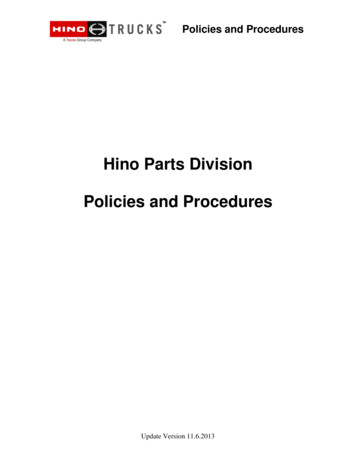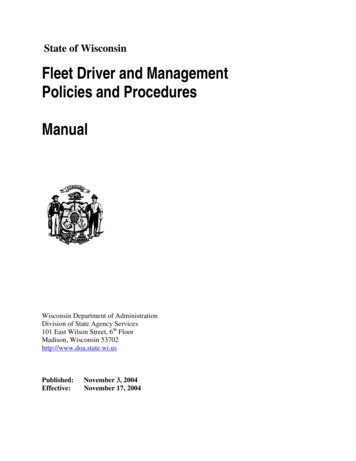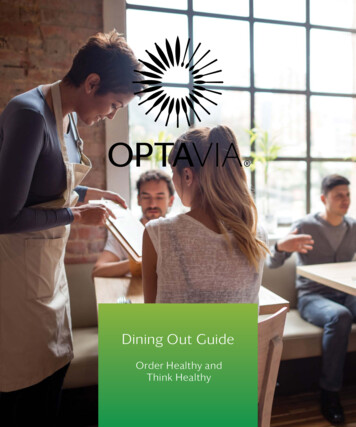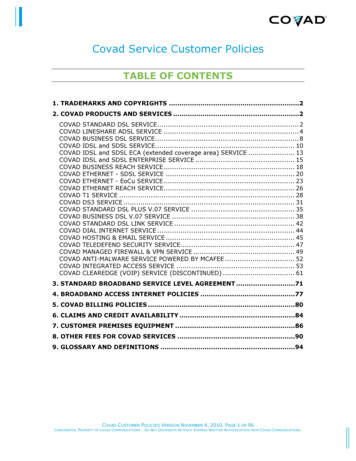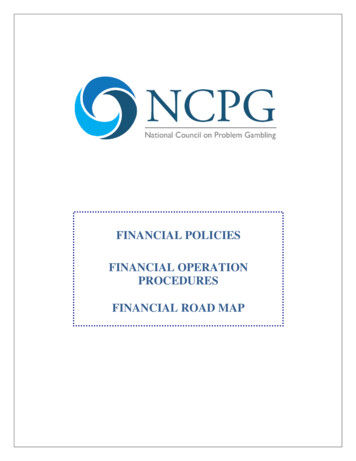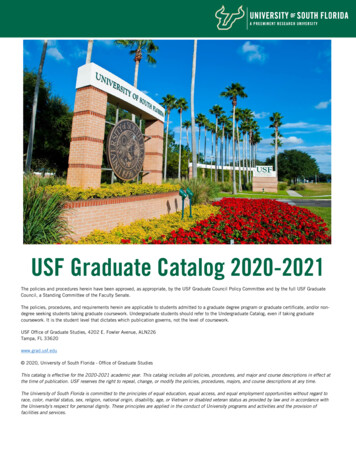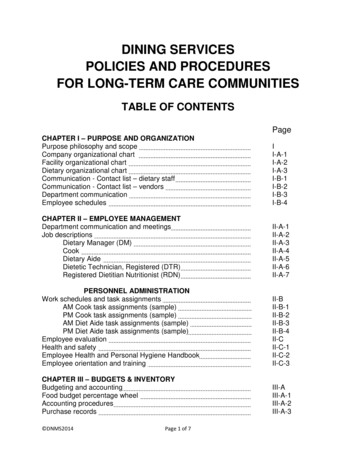
Transcription
DINING SERVICESPOLICIES AND PROCEDURESFOR LONG-TERM CARE COMMUNITIESTABLE OF CONTENTSPageCHAPTER I – PURPOSE AND ORGANIZATIONPurpose philosophy and scopeCompany organizational chartFacility organizational chartDietary organizational chartCommunication - Contact list – dietary staffCommunication - Contact list – vendorsDepartment communicationEmployee ER II – EMPLOYEE MANAGEMENTDepartment communication and meetingsJob descriptionsDietary Manager (DM)CookDietary AideDietetic Technician, Registered (DTR)Registered Dietitian Nutritionist SONNEL ADMINISTRATIONWork schedules and task assignmentsAM Cook task assignments (sample)PM Cook task assignments (sample)AM Diet Aide task assignments (sample)PM Diet Aide task assignments (sample)Employee evaluationHealth and safetyEmployee Health and Personal Hygiene HandbookEmployee orientation and -2II-C-3CHAPTER III – BUDGETS & INVENTORYBudgeting and accountingFood budget percentage wheelAccounting proceduresPurchase recordsIII-AIII-A-1III-A-2III-A-3 DNMS2014Page 1 of 7
DINING SERVICESPOLICIES AND PROCEDURESFOR LONG-TERM CARE COMMUNITIESTABLE OF CONTENTSCHAPTER III – BUDGETS & INVENTORY (continued)Record of invoices receivedRecords of invoices received (blank template)Expense spend-downGeneral ledger distributionFood and supply monthly/weekly accounting summary (cost report)Non-resident food events – guest mealsNon-resident food events – activities and special functionsNon-resident food events – facilities selling employee mealsNon-resident meals and special functionsOrdering food and suppliesMeal service itemsReceivingDamaged goodsResolving vendor I-C-1III-C-2III-DCHAPTER IV – FOOD PRODUCTION MANAGEMENTCycle menusMenu production sheet (sample)Meal replacement and food groups substitutionAlternate menu selectionMenu planning for nutritional adequacyMeal and nourishment service and time of serviceSnacks, nourishments and supplementsAlways available meal alternates and substitutesMechanically altered foodsDeviations from the regular portionsRecipes and recipe manualPortion controlPortion basics at a glanceCommon scoop sizesFood preparationDiet censusDiet census logProduction schedules and -1IV-C-2IV-C-3 DNMS2014Page 2 of 7.
DINING SERVICESPOLICIES AND PROCEDURESFOR LONG-TERM CARE COMMUNITIESTABLE OF CONTENTSCHAPTER IV – FOOD PRODUCTION MANAGEMENT (continued)Detailed daily production sheetProduction sheets – breakfast, lunch & dinnerFood handlingCooling HACCPFood temperature cooling logHACCP logs / R V – DINING PROGRAMSMeal service and set-upSetting up trays and tray line serviceTray sequence for meal serviceTray set-upTable set-upAssistive devices and equipmentDining program guidelinesTypes of dining programsFamily and social diningRecording food -C-1CHAPTER VI – NUTRITIONAL CARE MANAGEMENTWeight variance assessment and intervention (blank)Medical nutrition therapy (MNT) assessment processNutritional assessment process flowchartNutritional screening and data collection formsNutritional screening and data collection forms (blank)Nutritional risk factorsNutritional risk checklist – ranking scaleNutrition at Risk (NAR) CommitteeFood preferences interviewDietary quarterly progress notesDietitian referral logDehydration risk assessmentFree fluids restrictionPressure sore intervention protocolWeight variance assessment and interventionProtocol – decreased appetite poor intake or refusal of I-A-16 DNMS2014Page 3 of 7
DINING SERVICESPOLICIES AND PROCEDURESFOR LONG-TERM CARE COMMUNITIESTABLE OF CONTENTSCHAPTER VI – NUTRITIONAL CARE MANAGEMENT (continued)Clinical pathway – weight loss prevention flowchartAnthropometric system reviewFood fortification programSupplementation decision tree for weight loss interventionEnteral nutritionEnteral audit logDiet manualHouse dietsDiet order transmissionTray cardsDiets and color codes used in this facilityHydrationClinical role delineation according to scope of practiceClinical dietitian scope of responsibilityClinical dietitian & DTR orientation and trainingRegistered dietitian nutritionist competency reviewRDN/DTR reference clinical guidelinesWVC RDN quick reference guideAnalysis of avoidable vs. unavoidable weight 4VI-C-5VI-C-6VI-C-7VI-C-8CHAPTER VII – GENERAL SANITATIONSanitation standardsCleaning scheduleSanitation checklistTemperature records – cookingTemperature records – deliveriesTemperature records – equipmentTemperature records – cooking & cooling logFood thermometer calibrationThermometer calibration recordHandwashingGeneral sanitationEnvironmental safety – safety & accident preventionCabinets and drawersCan opener and baseCleaning of dining areasCleaning of 3VII-B-5VII-B-6 DNMS2014Page 4 of 7
DINING SERVICESPOLICIES AND PROCEDURESFOR LONG-TERM CARE COMMUNITIESTABLE OF CONTENTSCHAPTER VII – GENERAL SANITATION (continued)Coffee brewing equipmentMonitoring dishwashing machinesGeneral dishroom sanitationMachine dishwashing, drying and storageManual dishwashingJuice dispenserDry storage areasElectrical food machinesGarbage and trash disposalHoods, vents and filtersHot food tables, tray carts and shelvesCleaning of ice machinesIngredient binsStorage of cleaning supplies and janitor’s closetMops and mop bucketsPest control and monitoringRanges and ovensRefrigerator and freezer – dietaryRefrigerators in resident roomsSanitizing cloths in red bucketsShelves, countertops and other surfacesSteamers and steam kettlesWalls and ceilingsEmployee health and personal hygiene R VIII – DISASTER AND EMERGENCY MANAGEMENTDisaster and Emergency ManagementDisaster and mass casualty food serviceEmergency menuSuggested inventory guideServing sizes to provide approximately 2 oz. proteinEmergency water planWater heater instructionsEmergency food delivery listDisaster and emergency checklistEmergency disinfection drinking 5VIII-A-6VIII-A-7VIII-A-8VIII-A-9 DNMS2014Page 5 of 7
DINING SERVICESPOLICIES AND PROCEDURESFOR LONG-TERM CARE COMMUNITIESTABLE OF CONTENTSCHAPTER VIII – DISASTER AND EMERGENCY MANAGEMENT (continued)Plans for specific disastersVIII-BEarthquakeVIII-B-1Explosion – internal or externalVIII-B-2Fire – internal or externalVIII-B-3Extreme weather conditions including floodsVIII-B-4Hot weather hydration precautionsVIII-B-5Checklist for extreme heatVIII-B-6Extreme weatherVIII-BCHAPTER IX – DIETARY DEPARTMENT INSERVICE LESSON PLANSFood storageMaintaining hydrationMeal alternate selectionsSanitizing bucket – red bucketAccuracy of meals – condiments for therapeutic dietsDisaster and emergency proceduresFortified food diet protocolGlove useMechanically altered dietsMechanically altered diets – thin puree preparationSnacks and nourishmentsCooling foodDisaster & emergency management - This is an emergency!Food preparation for census, recipes, production sheet & menuFood preparation – meatsOpen refrigerated dairy and condiments storage guidelinesManual warewashing using 2 and 3 compartment sinksHow to prepare and serve thickened liquidsLow temperature machine dishwashingPortion sizes DNMS2014Page 6 of A-16IX-A-17IX-A-18IX-A-19IX-A-20
DINING SERVICESPOLICIES AND PROCEDURESFOR LONG-TERM CARE COMMUNITIESTABLE OF CONTENTSCHAPTER X- QUALITY ASSESSMENT PROCESSPROCEDURES, EVALUATION CRITERIA AND DATA COLLECTION FORMSQuality Assessment and Improvement (QAPI)X-A12 Action Steps to QAPIX-A-1Suggestions for implementing QAPI stepsX-A-1Quality Assessment of a Meal – Acceptance and Food IntakeX-A-2Tray AccuracyX-A-4Quality Assessment: Nutritional AdequacyX-A-5Nourishment DistributionX-A-6Quality Assessment of Congregate Dining ProgramsX-B-1Dining Enhancement Program ReviewX-B-2Quality Assessment of a Meal: System Analysis and Improvement PlanX-B-3Satisfaction QuestionnaireX-B-4Tracking Form: Storage of Refrigerated Foods ChecklistX-B-5Quality Assurance Process ImprovementX-B-6Accuracy of Fortified Food PreparationX-B-7Resident at Risk of Unplanned Weight LossX-B-8Quality Assessment of a Meal at Point of ServiceX-B-9CMS memorandum Summary – QAPI at a GlanceX-B-10 DNMS2014Page 7 of 7
CHAPTER IPURPOSE AND ORGANIZATIONPURPOSE PHILOSOPHY AND SCOPEDining services are designed to provide the highest quality nutritional care and foodservice.POLICYThe Dining Services Department will provide optimal nutrition care for residents.PURPOSEThe primary purpose of the Dining Services Department is to provide wholesome, safeand appetizing food that meets the nutritional and psychosocial needs of residents inkeeping with their stated wishes and the physician order in compliance with local, Stateand federal requirements and company standards for quality of service.PHILOSOPHYEach resident is an individual with a personality of his/her own. The resident comes tous with their lifetime habits and unique needs and experiences. Regardless of theirchoices, all will be met to the best of our ability with respect to their dignity andindividuality. DNMS2014Page 1 of 1I-A
CHAPTER IPURPOSE AND ORGANIZATIONFACILITY ORGANIZATIONAL CHART(Insert your Facility Organizational Chart)EXECUTIVE DIRECTORDIRECTOR OFNURSINGDIETARYMANAGER DNMS2014EXTERNALRESOURCESENVIRONMENTALPage 1 of 1OTHERDEPARTMENTSSection I-A-2
CHAPTER IIIBUDGETS AND INVENTORYBUDGETING AND ACCOUNTINGPOLICYDining Services Department will follow the budgets for labor, food, supplies, equipmentand capital expenditures, as established by the company and facility leadership eachfiscal year (FY).PURPOSETo ensure that the Dining Services Department will receive sufficient operating funds toprovide for residents' nutritional needs.PROCEDUREA.The Dietary Manager (DM) is responsible for maintaining the budgetbased on census and PPD given by the Executive Director.B.The required accounting systems are maintained and available for reviewand audit at all times.C.The DM is responsible for providing accounting information to theAdministrator upon request and at least monthly.D.The Registered Dietary Nutritionist (RDN) will provide guidance andsupport in maintaining the budget and assist the DM as needed. DNMS2014Page 1 of 1III-A
CHAPTER IIEMPLOYEE MANAGEMENTJOB DESCRIPTIONPOSITION TITLE: CookSUPERVISOR:Dietary Manager (DM)QUALIFICATIONS1. One (1) year quantity-cooking experience desired. Formal education graduation from high school. Ability to read, write and understand English.2. Sufficient job knowledge to plan production, know basic principles of quantityfood cookery, how to use major equipment and ability to read and follow recipes,production sheets and therapeutic diets.3. Sufficient accuracy to be precise when weighing and measuring food ingredientsand portions.4. Knowledgeable in basic standards of production and preparation of high qualityfoods in specified quantities.5. Knowledgeable in basic food safety and sanitation standards to store foodcorrectly and maintain area clean.6. Willingness and ability to provide supervision and guidance to dietary staff in theshift assigned to keep a safe, quiet and orderly environment and serve meals ontime.7. Ability to take instructions and follow through pleasantly and competently.8. Keep food handler card and health records current.ESSENTIAL JOB FUNCTIONS1. Prepare regular and therapeutic food items using standardized recipes to beserved at stated time. Check trays to assure resident receives proper food inproper amount. DNMS2014Page 1 of 3II-A-4
CHAPTER IIEMPLOYEE MANAGEMENT2. Prepare meat and main dishes, vegetables, soups and accompaniments forassigned meals per menu.3. Clean and wash equipment used in cooking.4. Keep own work area clean.5. Equipment used: food chopper, mixer, ovens, ranges, steamer, meat slicer.Report any damaged equipment to Dietary Manager.6. Maintain sanitation practices within regulatory and quality assurance standards.ADDITIONAL DUTIES1. Assist in supervising the work of the dietary personnel and is responsible whenDM is absent.2. Maintain inventory and inform DM of needed items.3. Basic knowledge on placing food orders to perform task in the absence of DM.PHYSICAL REQUIREMENTS1. Frequent lifting up to fifty (50) pounds.2. Frequent leaning, squatting and reaching.3. Frequent standing.4. Occasional pushing and pulling up to thirty (30) pounds.5. Repetitive fine manipulation and grasping. DNMS2014Page 2 of 3II-A-4
CHAPTER IIEMPLOYEE MANAGEMENTI have received a copy of my Job Description and understand the responsibilities of myposition.Employee Signature DateFacility Representative DNMS2014Date:Page 3 of 3II-A-4
CHAPTER IIPERSONNEL ADMINISTRATIONWORK SCHEDULESWORK SCHEDULES AND TASK ASSIGNMENTSPOLICYWork schedules will be provided to each employee.PROCEDUREA.Work Schedules1. The Dietary Manager (DM), with the aid of the Registered DietitianNutritionist (RDN) develops specific work schedules according todetailed tasks and times as appropriate to the facility.2. Sample work schedules and task assignments in this Manual are givenfor guidelines; these should be adjusted for specific tasks asappropriate to the facility.3. A work schedule and task assignment is specific for each position andposted in a visible location in the kitchen.4. Work schedules must be followed.5. If there is no task assignment work schedule for a position, the DM isresponsible for writing it and instructing the employee using the blankform in the next page.6. Some tasks are performed daily, others only as needed. The formshould indicate frequency, as well as recommended times thatcoincide with the daily schedule for each position. DNMS2014Page 1 of 2II-B
CHAPTER IIPERSONNEL ADMINISTRATIONWORK SCHEDULESWORK SCHEDULE TASK ASSIGNMENT SHEETJOB TITLE:(Do these tasks in the order given)TimeTaskInstructionsInstructions: Follow the posted cleaning list. You are responsible to your Supervisor. You maybe requested to do duties not listed on this schedule. DNMS2014Page 2 of 2II-B
CHAPTER IIPERSONNEL ADMINISTRATIONTASK ASSIGNMENTSPM DIET AIDE TASK ASSIGNMENTS (SAMPLE)11:00 AM to1:00 PM1:00 PM to1:15 PM1:15 PM to2:50 PM2:50 PM to3:00 PM3:00 PM to4:00 PM4:00 PM to4:45 PM4:45 PM to5:00 PM6:00 PM to7:00 PM7:00 PMClock in. Put on clean apron and hair cover. Wash hands. Help serveAM trayline, deliver carts, and answer requests for special items.Help AM Cook clean back kitchen. Wash all items.Check and prepare snacks, special needs items for dinner, andprepare beverages for dinner.Break.Wash hands. Finish preparing for meal service. Help dish salads anddesserts. Clean up area.Assist Cook preparing any dinner items and dishing up cold andindividual items. Prepare all special requests. Advance preparationand pouring for breakfast and lunch the next day.Set up tray line and get ready to start serving on time.Finish tray line and clean-up. Put all items away. Finish cleaning,washing dispensing equipment and leaving breakfast items ready. Setup breakfast tray cards and if necessary tray delivery carts.Clock out. Off duty.Other duties as assigned. DNMS2014Page 1 of 1II-B-4
CHAPTER IIPERSONNEL ADMINISTRATIONORIENTATION AND TRAININGEMPLOYEE ORIENTATION AND TRAININGPOLICYAll employees will receive appropriate orientation and training upon hire to perform therequired job.PROCEDURE1.All new employees:a.Attend the required facility orientation session prior to schedulingthe first day of work.b.Are given department sufficient training prior to working in thekitchen, using the equipment and preparing and serving food forresidents.2.The training includes department policies and procedures.3.The employee orientation guide and proof of skills competency iscompleted by each new hire, and signed by the employee uponcompletion, and retained in their file.4.The Dietary Manager is responsible for training employees and mayassign training with coworkers, as long as performance is closelysupervised and competency level is validated.5.All employees are expected to attend the scheduled training programs.6.Skills competencies of employees are validated routinely throughobservation of work performed and work outcomes, and oral and writtentesting. Results are kept in the employee file, shared with the employeeand the employee’s supervisor, and utilized to develop performanceimprovement plans. DNMS2014Page 1 of 1II-C-3
CHAPTER IIIBUDGETS AND INVENTORYPURCHASE RECORDSPOLICYIt is the policy of this facility that purchase records will be maintained for accuracy ofaccounting systems and budgetary compliance.PROCEDUREA.Invoices are recorded on Daily Record of Invoices Received Form andtotaled weekly. The original invoice is processed and a copy will beprovided to the Accounts Payable (AP) Department.B.A Special Functions Report Form is used to summarize purchases madeby the Dietary Department for special activities, functions or events forother departments (previously approved). The total amount spent onspecial functions is deducted from total food cost.1.When ordering food specifically for other departments, a separateinvoice may be requested from the vendor and submitted directly toAP Department for payment with the requesting department head’sapproval.2.If items are billed directly, do not include in the Monthly SpendDown or Accounting for Dietary Department; segregate anddocument in a separate Spend-Down and Accounting Form.C.The Dietary Food and Supply Monthly Accounting Summary is completedby the Dietary Manager monthly and submitted to the Administrator.D.Copies of forms and invoices will be kept for one (1) year in the DietaryDepartment, or in accordance with State requirements and companypolicy. DNMS2014Page 1 of 1III-A-3
Daily Record of Invoices ReceivedMonth of:Facility:Enter invoices daily. Add totals weekly. Grand total on the last day of the ollarsDairy-EggsDollarsGeneral GroceryDollarsMeatsDollarsProduceDollarsTotal DollarsTotal DollarsDNMS2014Page 2of 2III-A-4
Daily Record of Invoices ReceivedMonth of:Facility:Enter invoices daily. Add totals weekly. Grand total on the last day of the ollarsDairy-EggsDollarsGeneral GroceryDollarsMeatsDollarsProduceDollarsTotal DollarsTotal DollarsDNMS2014Page 2of 2III-A-4
CHAPTER IIIBUDGETS AND INVENTORYNON-RESIDENT FOOD EVENTS: ACTIVITIES AND SPECIALFUNCTIONSPOLICYThe Dining Services Department provides food items for social events to ensure thatadequate supplies are available for special activities.PROCEDURE1.The Activity Director requests items needed for a special function at leastone week in advance using the Special Functions Form.2.The Dietary Manager reviews and orders the food, processes the invoicesand completes the GL distribution as outlined in the Policy andProcedures. DNMS2014Page 1 of 1III-A-9
CHAPTER IVFOOD PRODUCTION MANAGEMENTMEAL REPLACEMENT AND FOOD GROUPS SUBSTITUTIONPOLICYA resident who refuses food served will be offered appropriate substitutes of similarnutritive value.PROCEDUREA.A list of available substitutions is posted by the Dietary Department.B.When a resident refuses a food item, nursing assistants check availablesubstitutions list and obtain resident's choice.C.The Dietary Manager follows up to identify food preferences and assistwith choices.D.When possible, substitution will provide a similar nutrient value to theuneaten foods.E.Nursing assistants document consumption of meal replacement or foodsubstitute on the Nursing Assistant Flow Sheets per facility policy.Food RefusedMeat, entreeMilkVegetableFruitBreadStarchDessert DNMS2014Appropriate SubstitutesCottage cheeseEggsSliced cheese or MeatPB&J sandwichAlternate Meat sandwichYogurtCottage cheeseSliced cheeseYogurtChocolate milkMilkshakeIce creamSoy milk, almond milkFruitFruit juiceVegetable soupVegetable juiceAlternate vegetableFruit juiceCrackers, cookiesCereal grainsBread, crackers, cookiesIce cream, yogurt, puddingPage 1 of 2Tortillas, pita, rice, couscous,amaranth, pastaCereal, cream soups, starchyvegetablesFruits, gelatin dessertsIV-A-2
CHAPTER IVFOOD PRODUCTION MANAGEMENTF.Residents who do not drink milk are given the following substitutes on adaily basis to ensure that adequate protein, calcium and calories areprovided:List of Suggested Milk Substitutes1 slice American cheese1 cup cottage cheese1 cup buttermilk1 cup yogurt1 cup milkshake, eggnog, malt1 cup ice cream1 cup soy milk1 cup almond milk ¾ cup milk 1/3 cup milk 1 cup milk 1 cup milk 1 cup milk 1/3 cup milk 1 cup milk (-1 gm protein) 1 cup milk (-4 gm protein)G.The Registered Dietitian Nutritionist (RDN) evaluates residents whocannot tolerate milk (or milk products) or otherwise accept milkreplacements in adequate amounts for the need of calcium, vitamin andmineral supplementation.H.The list of specific items added is noted in the Resident Profile (Kardex)Card and on the Tray Card. DNMS2014Page 2 of 2IV-A-2
CHAPTER IVFOOD PRODUCTION MANAGEMENTALWAYS AVAILABLE MEAL ALTERNATES AND SUBSTITUTESDear Resident: We strive to provide you with nutritious and delicious meals that meetyour expectations every day. If for any reason one day you do not like our offering,please select from one of the always available menu items. Selecting from these itemswill guarantee a very short wait. You are welcome to request other items and they willbe prepared at the end of meal service. Most items not listed will take between 30 and45 minutes to prepare.QUICK SERVICE OPTIONSSoup of the DayFresh Deli Cuts SandwichSmall Chef’s SaladFruit Plate with Cottage Cheese or Yogurt30 - 45 MINUTES OPTIONSTomato, Mushroom or Vegetable SoupGrilled SandwichQuesadillaOmelet DNMS2014Page 1 of 1IV-A-7
CHAPTER IVFOOD PRODUCTION MANAGEMENTDIET CENSUSA.A current diet census is maintained and posted to ensure that sufficientfood is prepared.B.A current diet census is maintained and posted in the kitchen for easyreference by dietary staff.C.All residents in the facility are included in the diet census.D.The diet census is used when ordering food and supplies and todetermine the amount of food to be prepared for each diet order daily. DNMS2014Page 1 of 1IV-C-1
CHAPTER IVFOOD PRODUCTION MANAGEMENTFOOD HANDLINGPOLICYFoods will be stored, prepared, and served in a safe manner.PROCEDUREA.Temperature Control1.2.B. DNMS2014Hot Food Temperaturesa.Potentially hazardous foods shall be heated to temperaturesof 160 F or greater.b.Temperatures of potentially hazardous foods shall be servedat 140 F or greater.Cold Food Temperaturesa.Temperatures of potentially hazardous foods shall bemaintained at 40 F or less until delivered to resident.b.Potentially hazardous foods will be stored at 40 F or belowuntil ready to use.Quality Assessment of Meals1.The Dietary Manager completes the quality assessment of a mealat least weekly for rotating meals.2.The form may also be used for time/temperature studies, as well asappearance and accuracy studies.3.The Registered Dietitian requests test trays to perform qualityassessment.4.The Dietary Manager may assign another qualified staff member toperform the quality assessment.Page 1 of 4IV-D
CHAPTER IVFOOD PRODUCTION MANAGEMENTFood CoolingC.D. DNMS20141.Any food item cooked or prepared hot and placed in the refrigeratoror freezer to cool is monitored to ensure that it reaches an internaltemperature of 41 F within four (4) hours.2.Check temperatures hourly and record on the Food TemperatureCooling Log. At the fourth hour, if the temperature has not reached41 F, discard the food immediately.3.In order to ensure that the desired temperature is achieved, cut allmeat into small pieces.4.Store food in shallow pans.5.Ice baths may be used.6.When food is in the cooling process, it can be left uncovered toexpedite cooling as part of the cooling process. Cover the foodwhen it reaches an internal temperature of 41 F.Leftovers1.Food that has been cooked and held for meal service on trayline isnot frozen and reused.2.Vegetables may be added to soups. Fruit may be used in gelatindesserts.3.Leftover dessert items may be used for nourishments.4.Leftover food is not prepared as a primary food item and is notused for pureed food.5.Leftover food is tightly covered, labeled with date and item nameand used within seventy-two (72) hours.a. Method 1: Thaw meat in open package under potablecold running water at with sufficient velocity to agitateand float off loose food particles with the overflow.b. Method 2: Thaw meat in a microwave oven as part of acontinuous cooking process using a conventionalcooking method, or when the entire, uninterruptedPage 2 of 4IV-D
CHAPTER IVFOOD PRODUCTION MANAGEMENTE. DNMS20146.cooking process takes place in the microwave oven.Internal temperature of meats must meet safetystandards.Thaw meats in the bottom shelf of the refrigerator in a spill-proofnon-porous receptacle to prevent dripping. Cured and pre-cookedmeats are thawed separately from raw meats. Red meat, poultryand pork are thawed separately.7.Do not refreeze thawed meat, fish or fowl.8.Cook thawed meat prior to freezing again.9.Thawed fruits and vegetables that were previously refrozen will loseflavor and general appeal; use for soups/stews.10.Precooked casseroles such as creamed dishes or those usingpotentially hazardous ingredients cannot be refrozen afterdefrosting.Prevention of Contamination Guidelines1.Wash hands before handling any food or when you are beginningany food preparation procedure. Hands should be washedregularly using the proper procedure for handwashing.2.Cover, label, date and refrigerate all leftovers as soon as serving iscompleted. Store food in clean, shallow storage containers.3.Cool foods in shallow pans in refrigerator, rather than leaving themout to cool at room temperature (See Procedure for Food CoolingProcess).4.Keep hot foods at 140 F or above and do not hold for longer than20-30 minutes before serving time.5.Use a clean spoon each time a food item is tasted.6.Do not remove ingredients for recipes from the refrigerator orstorage areas until time to use. Return them to refrigerator orstorage areas as soon as you are through with them.7.Use only clean and dry utensils and equipment to prepare food.Page 3 of 4IV-D
CHAPTER IVFOOD PRODUCTION MANAGEMENT8.Store all pre-poured beverages and pre-portioned foods inrefrigerator, covered and labeled until ready to serve.9.Use scoops to obtain ice from ice machine, and bulk staples suchas flour and dry cereal from bins. Store scoops in a separatecontainer with lid.10.Always use a clean, appropriate serving utensil to serve food never use your hand. If hands must be used (i.e. for sandwiches,cookies, etc.), wear clean, disposable gloves.11.Wash all fruits and vegetables thoroughly before preparing.12.Garbage will be placed in a leak-proof, non-absorbent containerwith liner and then disposed. The containers should be thoroughlycleaned after disposing of the waste.13.Clean aprons will be worn daily. Aprons are not worn outside theDietary Department.Freezing, Thawing and Refreezing Food Products14. DNMS2014Page 4 of 4IV-D
CHAPTER VDINING PROGRAMSTYPES OF DINING PROGRAMSPOLICYDining programs will be provided to promote social interaction, optimum diningatmosphere and improve residents’ appetite while meeting the physical capabilities ofeach resident.PROCEDUREResidents are evaluated upon admission, and as condition warrants, for dining abilityand assigned a program that meets their needs and ability. Residents are alwaysinformed of dining location and any changes recommended, and their approval isobtained.DINING PROGRAMSA.Dining programs are individualized for each facility.B.Dining programs are planned to accommodate resident needs and mayrequire more than one seating and location.1.2.Independent Dininga.For residents requiring no assistance at meal time, minimalsupervision in area to ensure resident’s safety, and highservice level.b.This program may be open dining, with residents attendingduring hours of operation and choosing their places, or withpre-scheduled service times and assigned seating.Assisted Dininga. DNMS2014For residents requiring minimal assistance, usually someset-up, opening of cartons or cutting some food, answeringmore frequent questions or obtaining additional mealreplacements or substitutes.Page 1 of 3V-B-1
CHAPTER VDINING PROGRAMS3.4.5.b.This program usually works more efficiently when hours ofservice, attendance and staffing are pre-scheduled.c.If space is an issue, this program works well in combinationof Dependent Dining.Dependent Dininga.For residents requiring assistance with most tasks, frequentcueing and reminding, staying in place until finished withmeal, and those that must be totally assisted by staff withmeals.b.This program may include residents exhibiting behavioral ordementia issues that may cause discomfort or unduedistractions to others. In this case, residents should beevaluated and a quieter, more private dining environmentmay be necessary.Restorative Dining or Progressive Eating Ski
Food fortification program VI-A-19 Supplementation decision tree for weight loss intervention VI-A-20 Enteral nutrition VI-A-21 Enteral audit log VI-A-22 Diet manual VI-B House die
